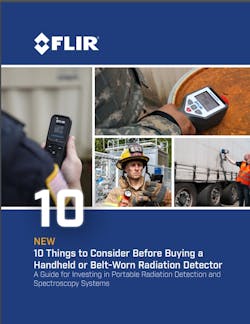FLIR Systems has published a new guidebook, which provides helpful tips for people involved with radiological detection, identification and monitoring who are looking for expert advice to help them evaluate and purchase the right tool for a deployment program.
Different radiological detection applications require different detector sizes and sensitivities. Some applications require smaller, more rugged devices while at other times, increased sensitivity outweighs the importance of deploying a compact, lightweight instrument. It can be a complicated decision, but it doesn’t have to be. This new guidebook, written by the CBRNE experts at FLIR Systems, provides 10 helpful tips for evaluating and selecting a handheld or belt-worn radiation detector.
Recognizing that your radiological detection is just one part of a deployment program the guidebook provides helpful advice regarding cost versus performance trade-offs in different application scenarios.
In addition, the guidebook answers questions including What level of sensitivity do I need? How should an instrument behave when pushed to its limit? and How do I plan and budget for long-term support of my deployment program?
To request a free copy of this informative new guidebook please visithttps://www.flir.com/discover/threat-detection/radiation/radiation-guidebook/ or contact FLIR Systems in Europe on +32-3665-5100 or [email protected].
Founded in 1978 and headquartered in Wilsonville, Oregon, FLIR Systems is a world-leading maker of sensor systems that enhance perception and heighten awareness, helping to save lives, improve productivity, and protect the environment. Through its nearly 3,500 employees, FLIR’s vision is to be “The World’s Sixth Sense” by leveraging thermal imaging and adjacent technologies to provide innovative, intelligent solutions for security and surveillance, environmental and condition monitoring, outdoor recreation, machine vision, navigation, and advanced threat detection. For more information, please visit www.flir.com and follow @flir



